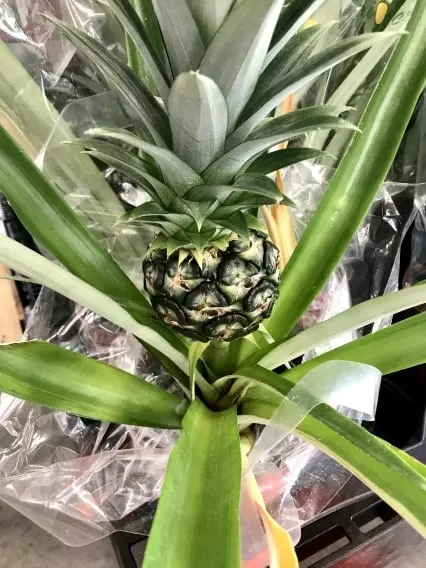The pineapple plant is a monocotyledon plant, native to tropical regions such as Mattogroso in South America located between Uruguay and Brazil. The pineapple plant cultivation is widely distributed to different countries and USDA regions due to its ease of cultivation. The pineapple plant can be easily grown indoors, outdoors, in pots. Even in areas with winter, without a tropical climate with proper advice, it is possible to grow the pineapple plant. How to harvest the pineapple plant and how to take care of it after the harvest. How to make your pineapple plant survive the winter. How Much Light Does a Pineapple Plant Need? What happens when a Pineapple Plant Leaves are Turning Brown. Our gardening experts will advise you on these topics and the proper proportions of Fertilizing the Pineapple Plant at different stages to understand all about Pineapple Plant Care.
The inflorescence contains between one hundred and two hundred flowers placed in a spiral form, fused to the central axis. The flowering lasts between thirty and sixty days approximately; the ripe fruit is obtained one hundred and thirty-five days after.
Depending on the variety, the fruit assumes a cylindrical or pyramidal shape and its weight varies according to the variety, planting density, climate, and management of the plantation.
The pineapple plant is typical of tropical climate zones. Although it is a perennial crop, it is only profitable with the production of two harvests, which in Costa Rica are produced in a period of approximately two and a half years. Consider a similar frequency for USDA regions if the temperature, fertilization plan, and light conditions are appropriate.
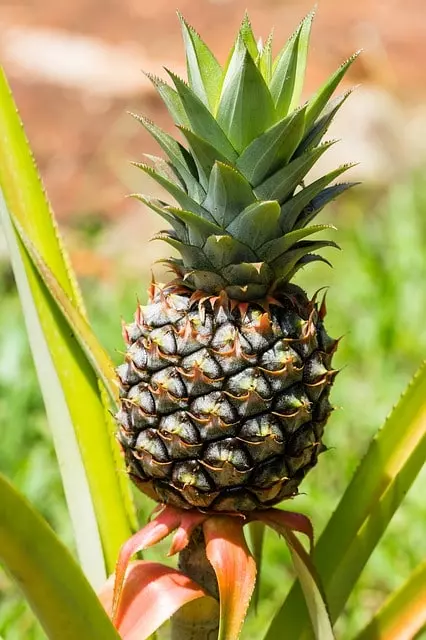
Table of Contents
How Much Light Does a Pineapple Plant Need
The optimum location should be warm, bright, and sunny throughout the year, with several hours of sunshine a day, avoiding bright midday sun, better sun in the morning and evening.
The brighter the location, the more intense the coloration of the leaves. High humidity is an advantage.
What Soil is Suitable for a Pineapple Plant
Pineapple belongs to Erdbromelien and prefers a loose, coarse substrate with a pH value of 5. Optimal is a suitable bromeliad substrate of peat and Lauberde in equal parts. Instead of peat, a compost-based, mineral- and lime-free soil can be used, which is also somewhat crumbly, loose, and, above all, well-drained.
A very important part of caring for your pineapple plant is the proper pH of the soil. It is advisable to measure and adjust the pH of the soil (Order it here). The pH 5 is the optimum that will allow and favor flowering and, therefore, the subsequent fruit formation.
We advise you to measure the pH of the soil around your pineapple plant. If the pH is not 5, the soil pH should be adjusted. Below, our experts tell you how to adjust the soil pH of a pineapple plant.
If you need to increase the pH the appropriate addition is lime (calcium carbonate). To reduce the pH you can add fertilizers based on organic manure, sulfur or aluminum sulfate, or pine needles.
How to Grow Pineapple at Home in Pot
Tip: a transfer of the pineapple is rarely needed, usually only when the pot or substrate is fully rooted.
It is produced at elevations between sea level and 900 meters above sea level. It requires temperatures between 73-86 F (23 and 30ºC), lower or higher temperatures significantly reduce leaf growth and the formation, ripening, and quality of the fruit.
High luminosity favors yield, good skin coloration, and good fruit quality.
Due to its morphological characteristics, the pineapple plant is not very demanding in terms of rainfall, since it takes water from atmospheric humidity.
The pineapple plant care is not very demanding on rainfall, since it takes water from atmospheric humidity, which gives it a great capacity to withstand dry periods.
However, it is produced under high rainfall regimes. Although pineapple tolerates relatively long periods of drought.
Although the pineapple plant could tolerate relatively long periods of drought, the lack of water when planting is established and at the onset of flower and fruit formation slows the growth and reduces fruit size.
In areas with high rainfall, fruit quality is poor, as the sugar content is low and acidity is high.
One of the soil factors that most limit the crop is the low permeability, especially in rainy climates, as this favors. This favors the attack of pathogens in the root system, so planting this crop in very clayey soils should be avoided.
This crop should not be planted in clayey soils with poor structure. The crop requires loose, aerated soils with excellent drainage.
Although medium-fertility is desirable, pineapple grows well in poor soils if adequate fertilization is provided.
Once the land has been cleared, plow it once (7.8-10 inches deep) (20-25 cm deep) and then track it twice in different directions. indifferent directions. The soil must be well loosened and free of vegetation residues. The planting beds are then prepared using a bedding machine or a tiller.
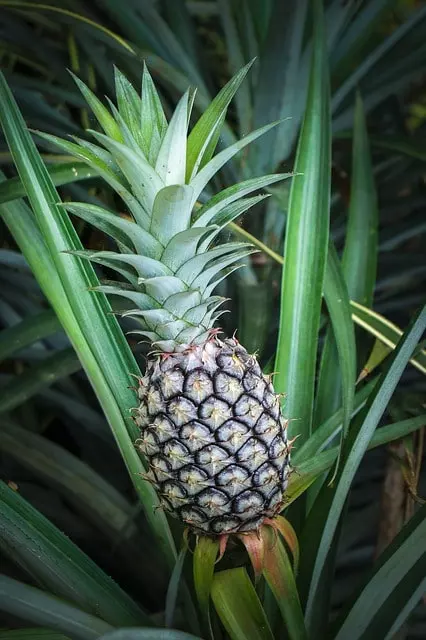
Yellow Leaves on Pineapple Plant
Pineapple Plant Leaves Turning Brown
Are the leaves of your pineapple plant turning yellow or brown?
Our experts will explain what happens to a pineapple plant when it starts to have yellow or brown leaves in the following paragraphs. Continue reading to learn about Pineapple plant care.
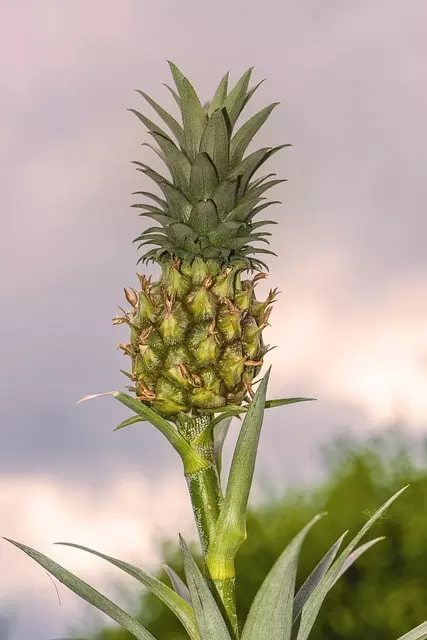
How to Fertilize a Pineapple Plant
Below our experts will explain the care to fertilize the pineapple plant at different stages of development, flowering to increase fruit yield. Continue reading to understand pineapple plant care.
Nitrogen and potassium are the most important nutrients for pineapple plant care. Nitrogen influences yield and potassium mainly influence fruit quality.
In the early stages of development, phosphorus application is recommended to contribute to good root development.
When the pineapple plant is 1 month old, we recommend a granular pineapple fertilizer (N-P-K) ratio of 12-24-12 or 10-30-10.
And then change to the proportions 20-3-20 or 18,5-15-6,2 for a pineapple plant of 2,5 and 5 months, to finally reach the proportion 15-3-31 after 6 months.
Between seven and a half and ten months of age and according to the development of the plant, a hormonal product is applied to induce flowering to shorten the production cycle.
This practice uniforms flowering and harvesting produces fruits of homogeneous size and reduces harvesting costs.
The application of hormones to obtain the second harvest is done six to eight months after the first harvest, that is, when the plant is two years old, to obtain the ripe fruit six months later.
The additive used to induce pineapple flowering is naphthaleneacetic acid, at a dose of 0.88 oz (25 grams) in 200 liters of water. The dose per plant is 1.8 in³ (30 cm³), which is sprayed directly on the heart of the rosette of leaves. It is also possible to apply 2-chloroethyl phosphoric acid, 18 in³ (300 cm³) in 53 gallons (200 L) of water.
One of the high-quality commercial products with these components that greatly enhance flowering and, therefore, will increase fruit production is naphthaleneacetic acid. We recommend using this product to induce flowering (Order it here).
Regardless of the product used for flower induction, the addition of urea to the solution 13 lbs/53 gallons of solution (6 kg/200 L), increases the number of flowers per plant.
Adding flower induction to the pineapple plant should be carried out under conditions of low temperature and luminosity (cool days, in the morning, afternoon, and, if possible, in the evening). and if possible at night).
Pests of the Pineapple Plant
Pests of the Pineapple Plant: Mealybug Dysmicoccus brevipes
These insects are small, oval-shaped, somewhat flattened, and soft-bodied; they are covered with a whitish waxy powder, with lateral filaments of the same color. They suck sap both from the roots and from the stem, below and above ground, where colonies are found in symbiosis with ants. The high populations of this insect cause yellowing and stunting.
This insect is a transmitter of the pineapple wilt virus or “Wilt”.
One of the most appropriate measures to combat this pest is to plant the shoots free of the insect and in non-infested soils. and in non-infested soils.
The soil should be prepared, cleaned well and the plants that serve as shelter should be eliminated.
Because of the location of this pest on the plant, it is quite protected from natural enemies, although the Hemiptera Acerophagus debilis has been identified as a parasite.
Combating ants before and after planting helps to manage the pest.
Pineapple Plant Leaves Turning Brown
In the fruit, the larvae cause hollows or cavities from which gummy exudations emanate and are also the entrance of fungi and bacteria such as Fusarium sp. and Penicillium sp., diseases that give the pulp a blackish-brown coloration, commonly known as “pineapple clove”.
There are some natural enemies of this pest. However, these have not yet been properly identified.
Cutting Pineapples – How to Harvest Pineapples
The right time to harvest this fruit depends on its destination. If it is for export, it should be harvested when the fruit is fully seasoned, in the early stages of ripening, but green; if it is for the domestic market, the fruit is harvested just ripe, not at an advanced stage of maturity.
Harvesting is done by hand; the fruit is rotated to detach it from the peduncle. The other option is to cut the fruit at the stalk with a knife, being careful not to hit or injure the fruit.
Pruning in the true sense is not necessary for pineapple. Only the fruit should be cut for fruit maturity. Pineapple can take 1-4 years to flower for the first time. The fruit develops in 4-8 months and with increasing maturity becomes more and more yellowish discolored, emanates an increasingly intense fragrance, and the flesh yields under pressure with the finger.
The pineapple can now be cut from the stem with a knife. The remaining leaf rosette usually dies thereafter, but should not be discarded because it forms small shoots during death.
Tip: pineapple fruits that ripen in summer are usually more aromatic than those that ripen in winter.
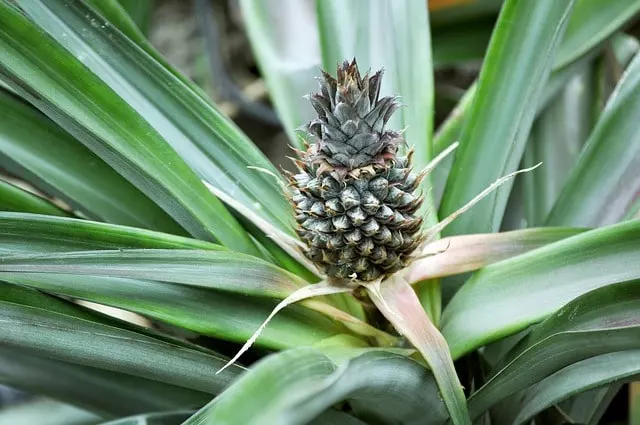
Can a Pineapple Plant Survive the Winter?
Can Pineapple Plants Grow Indoors?
Overwintering the pineapple plant. When hibernating pineapple is not much to pay attention to it. It should remain warm and bright, room temperature not lower than 55 F (17 C), and a reduced supply of water and nutrients.
When you are moving or growing the pineapple plant indoors during winter, due to the dry heating air, it is advisable to regularly spray them with water, which can also counteract an infestation of pests.
Specimens that were outdoors should be brought indoors before autumn at the latest.
Growing a pineapple is relatively easy if you take into account a few small things. However, it can take time to root and not all attempts are successful.
How Long Does it Take to Grow a Pineapple?
To grow a pineapple can take up to 4 years to develop fruit for the first time. However, following our tips, the long wait will be rewarded with a delicious self-harvested pineapple.
How to Propagate Pineapples
Since this is a perennial plant but after 2 harvests it will stop bearing fruit, it is useful to propagate it to perpetuate the crop. With our instructions, you will find that propagating the pineapple plant is easy and fast.
The expert gardeners of our team will help you by explaining the ways to effectively propagate the pineapple plant, using different methods, comparing their effectiveness (top vs. seed). Learn how to propagate your pineapple plant in these articles How to Propagate Pineapple Step by Step and How Long for a Pineapple to Grow.
Homemade Organic fertilizers: check these articles Coffee Grounds for Plants – Organic Fertilizer and Eggshells for Plants in the Garden – Organic Fertilizer.
Learn more about fertilizers Different Types of Fertilizers – Ultimate Guide
